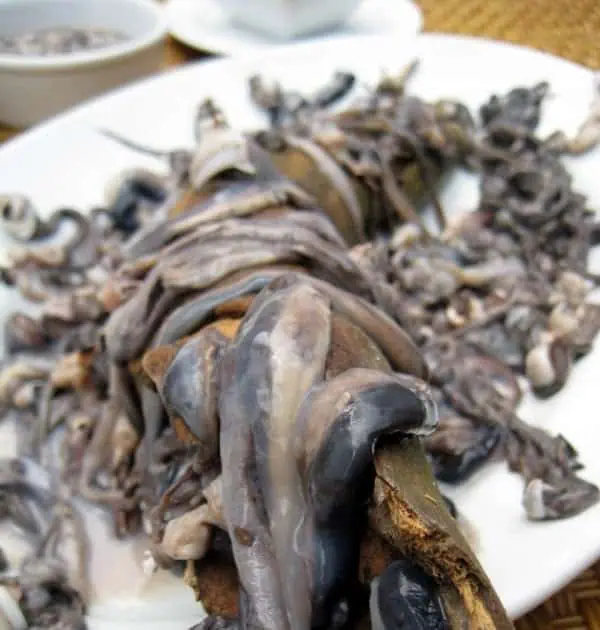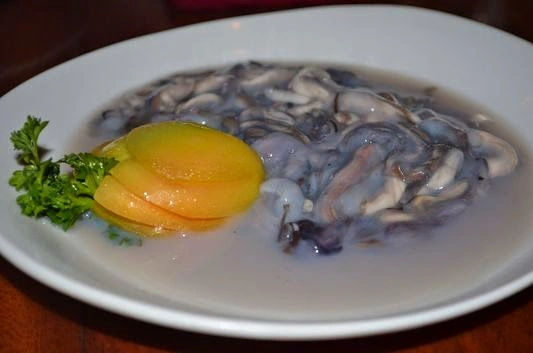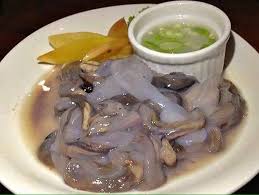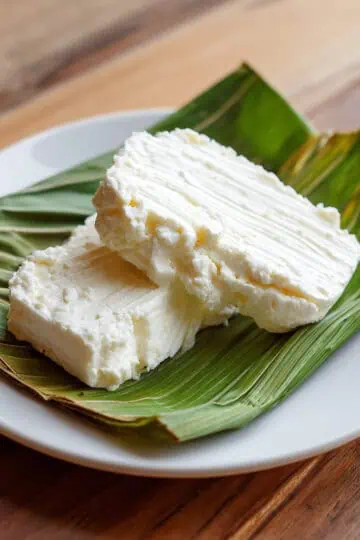After years of perfecting this authentic Filipino delicacy during my trips to Palawan, I'm excited to share my Kinilaw na Tamilok recipe with you. When I first tried this exotic "woodworm" (actually a type of clam!), I was amazed by its fresh, delicate flavor. This simple dish transforms the unique tamilok into a zesty, tangy appetizer using just a handful of fresh ingredients and no cooking required.
It's been a hit at my dinner parties, even among friends who were initially hesitant to try it. If you're looking to impress with something truly special or experience genuine Filipino flavors, this 15-minute recipe is your ticket to culinary adventure.
What is Tamilok?
Tamilok is a unique Filipino delicacy that many people mistakenly call a "woodworm," but it's actually a marine mollusk - specifically a shipworm (Teredo navalis). This mollusk is a type of saltwater clam that burrows into submerged wooden structures like mangrove trees, which is why it gets the woodworm nickname.
In terms of culinary use, tamilok is most commonly prepared as "kinilaw" - a Filipino ceviche-style dish where it's marinated in vinegar and citrus juices (usually calamansi), which effectively "cooks" the mollusk through acid. When prepared properly, tamilok has a soft, creamy texture similar to oysters with a mild, slightly sweet flavor profile.
Tamilok is considered a delicacy in the Philippines and has become somewhat of a tourist attraction with visitors to Palawan often taking on the challenge of tasting this unusual seafood. It's nutritionally rich in protein and is harvested as a sustainable food source when taken from fallen mangrove wood rather than living trees.
Jump to:
Why You'll Love This Recipe
You'll fall in love with this authentic Kinilaw na Tamilok recipe because it's:
- Quick and simple - ready in just 15 minutes with minimal preparation
- Refreshingly tangy - the perfect balance of acidity and freshness
- An impressive exotic dish - perfect for surprising guests with an authentic Filipino experience
- Rich in protein - a nutritious seafood option with a unique texture
- True to traditional techniques - prepared the way locals in Palawan have enjoyed for generations
Ingredients
Each ingredient in this recipe serves an essential purpose. The acidic calamansi juice and vinegar "cook" the tamilok while bringing out its natural sweetness. Red onions add a sharp contrast and crunchy texture, while siling labuyo provides a spicy kick that balances the richness of the tamilok.
Together, these simple ingredients create the perfect balance of flavors – tangy, spicy, and fresh – that highlight rather than overpower the delicate taste of this unique seafood delicacy.

- 10-20 pieces fresh tamilok (woodworm/shipworm)
- 4 tablespoons finely chopped red onions
- ½ tablespoon chopped siling labuyo (bird's eye chili pepper)
- 4 tablespoons freshly squeezed calamansi juice
- ¼ cup white vinegar
- Pinch of salt (optional)
- 1 tablespoon chopped cilantro or scallions (optional, for garnish)
Equipment
- Sharp knife - for cleaning and preparing the tamilok
- Glass or non-reactive mixing bowl - metal bowls may react with the acids
- Citrus juicer - for extracting fresh calamansi juice
- Cutting board - for chopping ingredients
- Measuring spoons - for precise ingredient portions

How To Make
- Clean the tamilok thoroughly under cold running water.
- Remove the hard portion from the head of each tamilok piece.
- Place the cleaned tamilok in a glass or non-reactive mixing bowl.
- Add the finely chopped onions and siling labuyo to the bowl.
- Pour the freshly squeezed calamansi juice and vinegar over the mixture.
- Mix well but gently to ensure all tamilok pieces are coated with the acid mixture.
- Let it sit for 5 minutes until the tamilok turns opaque, indicating it's "cooked" by the acid.
- Adjust seasoning with a pinch of salt if desired.
- Garnish with cilantro or scallions if using.
- Serve immediately as an appetizer with your favorite beverage.

Tips from Lola's Kitchen
- Freshness is key - Always use freshly harvested tamilok for the best flavor and safety.
- Proper acid ratio - The vinegar and calamansi mixture should fully "cook" the tamilok, so don't reduce the acid content.
- Chill before serving - For an extra refreshing experience, chill the mixture for 5 minutes before serving.
- Spice control - Adjust the amount of chili pepper according to your heat preference.
- Color indicator - Properly "cooked" tamilok will turn from translucent to opaque white.
Substitutions
- Calamansi juice: If unavailable, use 2 tablespoons of lime or lemon juice with 1 teaspoon of orange juice.
- Siling labuyo: Substitute with Thai bird's eye chili or serrano peppers.
- White vinegar: Coconut vinegar or apple cider vinegar can be used for a different flavor profile.
- Red onions: White onions or shallots work well too.
- Tamilok: While there's no true substitute for this unique ingredient, very fresh oysters prepared kinilaw-style can provide a similar experience.
Troubleshooting
- Too sour? Add a small pinch of sugar to balance the acidity.
- Too spicy? Increase the amount of onions and add a tablespoon of grated cucumber.
- Tamilok still appears translucent? Let it marinate longer in the acid mixture until it turns opaque.
- Texture too rubbery? The tamilok may have been over-marinated; next time, reduce the acid exposure time.
- Mixture too watery? Drain some of the excess liquid before serving.
Storage & Reheating
- Best consumed fresh - Kinilaw na Tamilok is meant to be enjoyed immediately after preparation.
- Short-term storage - If necessary, store in an airtight container in the refrigerator for up to 4 hours.
- Not for reheating - This is an acid-cooked dish and should never be heated with conventional cooking methods.
- Appearance changes - Note that the texture and flavor will continue to change in storage as the acid continues to "cook" the tamilok.
- Food safety - Due to the raw nature of the ingredients, extended storage is not recommended.

FAQ
Is tamilok safe to eat?
Yes, when fresh and properly prepared in acid (like vinegar and citrus juice), tamilok is safe to consume. The acid effectively "cooks" the mollusk.
What does tamilok taste like?
Tamilok has a delicate, slightly sweet flavor similar to oysters, with a soft, creamy texture.
Where can I find tamilok?
Tamilok is primarily available in coastal areas of the Philippines, especially Palawan. It's rarely found outside the country in its fresh form.
Can pregnant women eat kinilaw na tamilok?
As with any raw seafood dish, pregnant women, young children, elderly, and those with compromised immune systems should avoid consuming kinilaw na tamilok.
What drinks pair well with kinilaw na tamilok?
Traditional Filipino beer, coconut water, or a dry white wine complement the tangy flavors of kinilaw na tamilok beautifully.
Is tamilok environmentally sustainable?
When harvested responsibly from fallen mangrove wood rather than cutting living trees, tamilok can be considered a sustainable food source.
Can I prepare kinilaw na tamilok in advance for a party?
It's best prepared just before serving, but you can prepare all ingredients separately and combine them 5-10 minutes before guests arrive.
Related
Looking for other recipes like this? Try these:

Kinilaw na Tamilok (Woodworm)
Ingredients
- 10-20 pieces fresh tamilok woodworm/shipworm
- 4 tablespoons finely chopped red onions
- ½ tablespoon chopped siling labuyo bird's eye chili pepper
- 4 tablespoons freshly squeezed calamansi juice
- ¼ cup white vinegar
- Pinch of salt optional
- 1 tablespoon chopped cilantro or scallions optional, for garnish
Instructions
- Clean the tamilok thoroughly under cold running water.
- Remove the hard portion from the head of each tamilok piece.
- Place the cleaned tamilok in a glass or non-reactive mixing bowl.
- Add the finely chopped onions and siling labuyo to the bowl.
- Pour the freshly squeezed calamansi juice and vinegar over the mixture.
- Mix well but gently to ensure all tamilok pieces are coated with the acid mixture.
- Let it sit for 5 minutes until the tamilok turns opaque, indicating it's "cooked" by the acid.
- Adjust seasoning with a pinch of salt if desired.
- Garnish with cilantro or scallions if using.
- Serve immediately as an appetizer with your favorite beverage.
Tips from Lola's Kitchen
- Freshness is key - Always use freshly harvested tamilok for the best flavor and safety.
- Proper acid ratio - The vinegar and calamansi mixture should fully "cook" the tamilok, so don't reduce the acid content.
- Chill before serving - For an extra refreshing experience, chill the mixture for 5 minutes before serving.
- Spice control - Adjust the amount of chili pepper according to your heat preference.
- Color indicator - Properly "cooked" tamilok will turn from translucent to opaque white.
The Story Behind Kinilaw na Tamilok
Kinilaw na Tamilok has a fascinating story deeply rooted in Filipino coastal culture and resourcefulness. This unique delicacy emerged from the ingenuity of indigenous communities in Palawan, who first discovered these creatures while building boats and working with mangrove wood.
Long before Spanish colonization brought European influences to Philippine cuisine, native Filipinos had mastered the art of "cooking" seafood in vinegar and citrus juices. This technique, known as "kinilaw" (similar to Latin American ceviche), became an essential method of food preparation in a tropical climate where refrigeration didn't exist.
The discovery of tamilok was likely accidental. While working with mangrove wood, early Palawan residents noticed these creatures burrowing inside fallen logs. Rather than considering them pests, the resourceful locals recognized their potential as a food source. They applied their traditional kinilaw preparation method, and a delicacy was born.
Despite its unusual appearance and habitat, tamilok quickly earned a reputation for its surprisingly delicate flavor. Indigenous communities passed down their preparation techniques through generations, with each family developing subtle variations of the classic recipe.
Today, Kinilaw na Tamilok has evolved from a local sustenance food to a celebrated cultural symbol of Filipino culinary adventure. While primarily enjoyed in coastal regions like Palawan, Puerto Princesa, and parts of Aklan, this dish has gained international recognition as adventurous food tourists seek authentic Filipino experiences.
What makes Kinilaw na Tamilok truly special is how it represents the Filipino spirit of "nothing goes to waste" and the ability to transform unexpected ingredients into delicious cuisine. The dish stands as a testament to the resourcefulness, creativity, and sustainability practices that have been part of Filipino food culture for centuries.
As you prepare this recipe, you're not just making a dish—you're participating in a culinary tradition that connects you to generations of Filipino coastal communities and their harmonious relationship with their natural environment.










Comments
No Comments